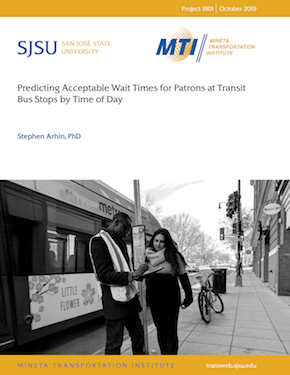- 408-924-7560
- mineta-institute@sjsu.edu
- Donate
Predicting Acceptable Wait Times for Patrons at Transit Bus Stops by Time of Day
The time spent waiting by bus patrons at bus stops is a primary measure for assessing the reliability of transit services. Uncertainty associated with waiting affects bus patrons’ perception of quality of the service provided. Consequently, this study aimed to determine patrons’ maximum and minimum acceptable wait times at bus stops in Washington, DC and to develop prediction models to provide decision-makers with additional tools for improving patronage.
The data used in this study was obtained by surveying 3,388 bus patrons at 71 selected bus stops in Washington, D.C. over an eight-month period. Data obtained from patrons included their ethnicity, gender, minimum and maximum acceptable wait times (beyond the scheduled bus arrival time), alternate transportation mode choice, and knowledge of bus arrival times. Additionally, data on the operational characteristic of the buses were obtained via video playback of video recordings of cameras installed at the selected bus stops. In addition, information and conditions at each bus stop at the time of each survey was recorded. Statistical analyses were conducted to determine if there were any statistically significant differences in the maximum acceptable wait time of patrons based on gender and ethnicity. Further, models were developed to predict the maximum acceptable wait time of patrons.
From the results, the mean of the reported maximum acceptable wait time was 8.5 minutes and 8 minutes, for female and male patrons, respectively. Also, the highest reported acceptable wait time beyond the scheduled bus arrival time was 20 minutes, while the mean differences between the maximum acceptable wait times of patrons grouped by ethnicity were determined to be statistically significant at a 5% significance level. Also, the results showed that White patrons had statistically significant lower maximum acceptable wait times than did patrons of other racial/ethnic groups.
STEPHEN ARHIN, PhD, PE, PTOE, PMP, CRA, Fellow ITE
Dr. Arhin is an Associate Professor of the Department of Civil and Environmental Engineering of Howard University, the Director of the Howard University Transportation Research and Traffic Safety Data Center (HUTRC), and the Associate Director of the transit research conducted by Howard University under the Mineta Consortium for Transportation Mobility. His experience spans more than 20 years in all facets of transportation and traffic safety engineering, including traffic safety and operations, research, planning, transit operations and ITS. He has extensive experience working with state and local transportation agencies on a wide variety of safety, operations, and design projects. Prior to his tenure at HUTRC, he was a Senior Traffic Engineer with a number of nationally recognized engineering consulting firms. Dr. Arhin has co-authored several project reports, published articles in peer-reviewed journals and presented at conferences on such topics as countdown pedestrian traffic signals, intelligent transportation technologies, pavement condition monitoring, crash data analysis, traffic volume trends, mitigation of reflective cracking in composite highway pavements, truck weight enforcement and red-light violation index. He is a member of ITE, TRB and ASCE and serves as a peer reviewer for several journals. He is the current Vice President of the DC Society of Professional Engineers and a Fellow Member of the Institute of Transportation Engineers.
This research was supported by the following research assistants at HUTRC:
- Adam Gatiba
- Melissa Anderson
- Babin Manadhar
-
Contact Us
San José State University One Washington Square, San Jose, CA 95192 Phone: 408-924-7560 Email: mineta-institute@sjsu.edu






